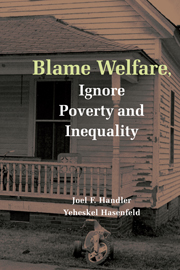Book contents
- Frontmatter
- Contents
- Acknowledgments
- List of Acronyms
- 1 Introduction
- 2 The State of Poverty: TANF Recipients
- 3 The Response to Poverty and Inequality: The Welfare State
- 4 Demonizing the Single-Mother Family: The Path to Welfare Reform
- 5 The Welfare Bureaucracy
- 6 Work and the Low-Wage Labor Market: Mothers and Children
- 7 Welfare Reform and Moral Entrepreneurship: Promoting Marriage and Responsible Parenthood and Preventing Teenage Pregnancy
- 8 Addressing Poverty and Inequality
- References
- Author Index
- Subject Index
2 - The State of Poverty: TANF Recipients
Published online by Cambridge University Press: 20 August 2009
- Frontmatter
- Contents
- Acknowledgments
- List of Acronyms
- 1 Introduction
- 2 The State of Poverty: TANF Recipients
- 3 The Response to Poverty and Inequality: The Welfare State
- 4 Demonizing the Single-Mother Family: The Path to Welfare Reform
- 5 The Welfare Bureaucracy
- 6 Work and the Low-Wage Labor Market: Mothers and Children
- 7 Welfare Reform and Moral Entrepreneurship: Promoting Marriage and Responsible Parenthood and Preventing Teenage Pregnancy
- 8 Addressing Poverty and Inequality
- References
- Author Index
- Subject Index
Summary
The Myth and Reality of Poverty in America
The United States has the astonishing distinction of having one of the highest rates of poverty in the industrialized world, despite having one of the highest average incomes. The latest figures show an increase in the number of people in poverty from 32.9 million in 2001, to 35.9 million in 2003, to 37 million in 2004. The poverty rate rose from 11.7 percent (2001) to 12.7 percent in 2004. More ominously, the United States also has the highest child poverty compared with thirteen western European countries and Canada. How did we earn such a distinction? The United States believes in the central importance of personal independence through earnings in the paid labor force. Other policies are viewed in terms of whether they create incentives or disincentives to achieving this goal. Thus, with the exception of the aged, only mixed, if not suspicious, support is reserved for those considered outside of the labor force (unemployed, disabled). There is begrudging support for those who are considered poor but able bodied. There has never been public support to combat poverty by reducing income inequality, even though increasing inequality is a major reason poverty is so high in the United States. An exception is the Earned Income Tax Credit (EITC) for the working poor, which is discussed in Chapter 3.
- Type
- Chapter
- Information
- Blame Welfare, Ignore Poverty and Inequality , pp. 17 - 69Publisher: Cambridge University PressPrint publication year: 2006



